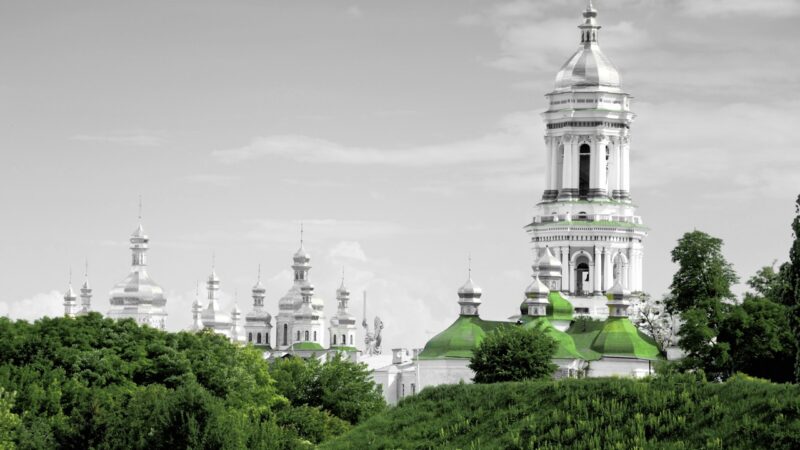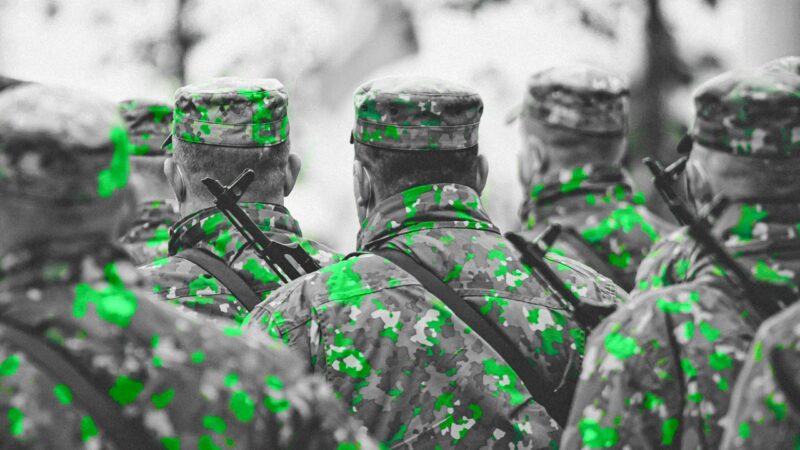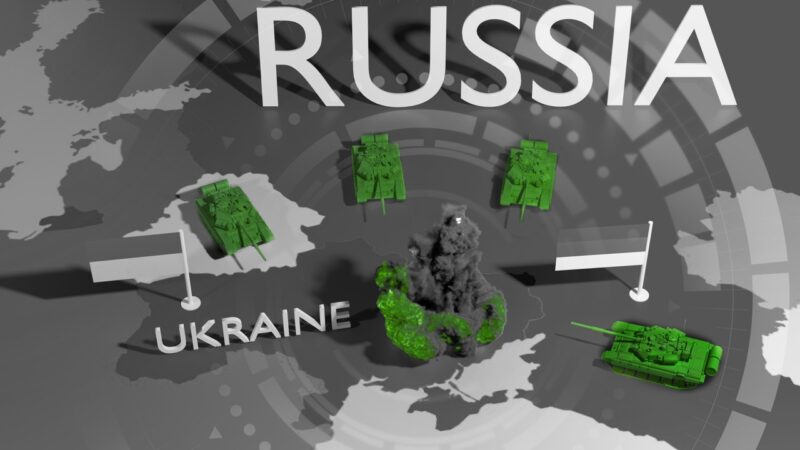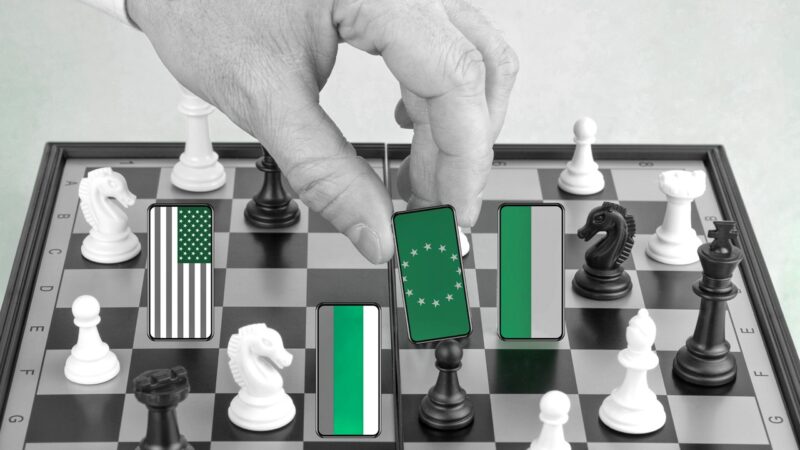Presidential election in Ukraine: A dilemma of quality and of quantity
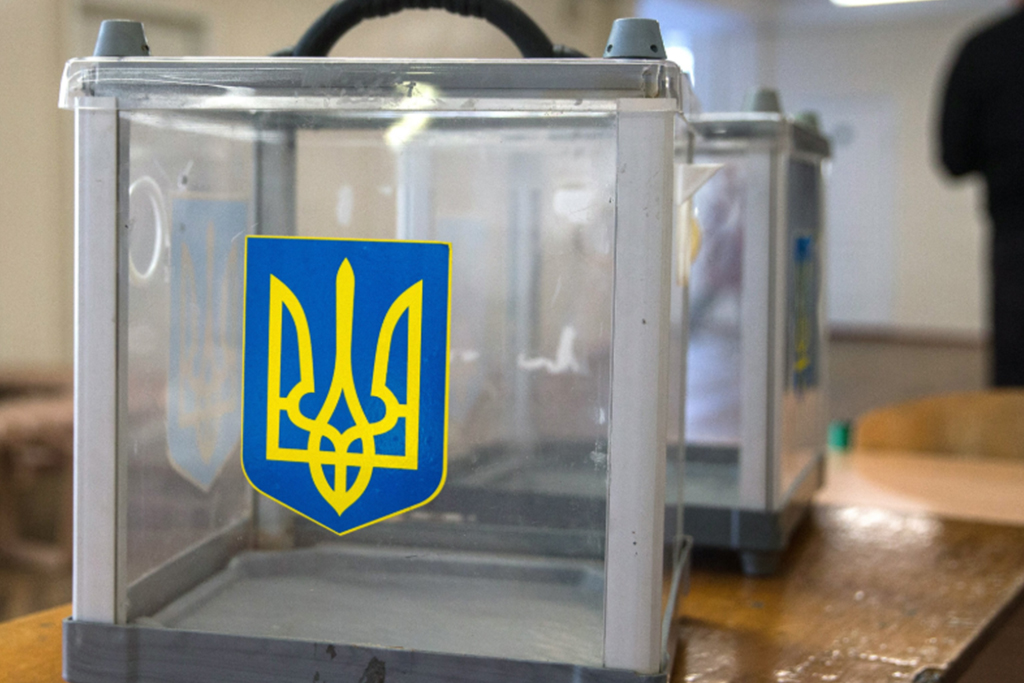
The upcoming presidential election in Ukraine that are to be held on March 31 promise to include the largest number of candidates in the history of the country since it gained independence in 1991. In total, the Central Electoral Commission of Ukraine has registered forty-four contestants for the president’s chair. The candidates belong to a variety of political forces, including representatives from the ruling coalition and from opposition parties, as well as high-ranking executives. On the one hand, such a substantial number and dispersion of the candidates seemingly demonstrates unrestricted access to competition for the highest political office in Ukraine. On the other hand, however, it poses the challenge of differentiating between all the politicians, with their diverse platforms and strategies, and of understanding their political agendas.
Ukrainian political figures are known for not holding well-articulated ideological positions, and for being tactical rather than strategic in their policies and platforms.[i] However, the changes in Ukrainian society instigated by the Euromaidan protests in 2014 did prompt a repositioning of political parties: some of the political forces disappeared (such as the Communist Party of Ukraine), some were reshaped (such as the Party of Regions), and some new ones appeared (such as Self-Reliance and the Radical Party). Thus, we shall endeavour to present here a systematization of the presidential candidates’ political views along the political spectrum, with the aim of facilitating a better comprehension of Ukrainian politics within a Western framework.
To that end, we set ourselves the task of placing the contestants along the political spectrum, a scale often used to systematize the political views of people based on their positions on key delimitative issues, such as welfare economics (command economy) vs uncontrolled laissez-faire market, or authority vs liberty. Following the dominant approach of differentiating between the economic and social axes,[ii] and considering different approaches to positioning them on a Cartesian coordinate plane,[iii] we decided to use a version of the chart proposed by Political Compass,[iv] as the most widely used and intuitive model. The chart positions the axes as follows: the X-axis tracks economic approaches (economic left to economic right), while the Y-axis tracks social approaches (libertarian to authoritarian). Thus, in reading order, the chart forms quadrants of authoritarian left, authoritarian right, libertarian left, and libertarian right.
In order to avoid overburdening the research results with the analysis of spurious candidates, we decided to include only those politicians who are known to the electorate and therefore have a real chance of receiving decided votes. Namely, we studied only the twelve candidates who scored at least 1% in the opinion polls that were conducted after the registration deadline passed.[v] Six of them are current deputies to the Ukrainian parliament, the Verkhovna Rada: Yuliia Tymoshenko, Yurii Boiko, Oleksandr Vilkul, Oleh Liashko, Yevhenii Muraiev, and Oleksandr Shevchenko. Three of the twelve—Boiko, Muraiev, and Vilkul—are members of the opposition, while Tymoshenko and Liashko are members of the coalition. Another candidate is from the legislative branch of government—Ruslan Koshulynsky, who is a deputy to the Lviv Oblast Rada. As for the rest, the majority of them hold, or have held, high-ranking positions on the executive side: Petro Poroshenko is the incumbent president of Ukraine, Anatolii Hrytsenko is a former minister of defence, and Ihor Smeshko is a former head of the Security Service of Ukraine. Finally, the only candidate that has no political experience is Volodymyr Zelensky, a popular comedian and film director.
Since the presidential candidates under study are members of different political institutions (if any), one possible common descriptor of their political ideology is their political platform. Thus, we considered the political platforms of all the candidates, and on this basis located them on the plane of the above-defined political spectrum. Each campaign platform was reviewed, and based on the economic and social attitudes presented, the respective candidate was assigned a relative position in one of the quadrants of the political spectrum. However, we realized that a political platform does not necessarily fully or faithfully translate the political views of a candidate. Therefore, in order to provide a more reliable estimation, we also considered the legislative proposals that were written or co-authored by candidates who are current members of parliament. For those candidates, first we located them on the spectrum based on their draft legislation, and estimated the percentage ratio of categorized legislative proposals in relation to the total number of each candidate’s proposals. Then, we adjusted their position on the spectrum, taking into consideration their overall political platform. This allowed us to formulate a much more conclusive picture of the political standing of those candidates.
The Illusion of Choice
Analysis of the legislative activity of the presidential candidates who are currently sitting in the Verkhovna Rada of Ukraine, as well as of the incumbent president, provides an illuminating picture. Namely, although the MPs and the President represent different political forces and hold distinct political views, their positions on the political spectrum are quite similar. Based on the legislative proposals they submitted during the current session (VIII Convocation of the Verkhovna Rada), all of them were located in the authoritarian-left quadrant.

It is evident that only two candidates are relative outliers from the main group in this quadrant: Muraiev, who is located at only −3% on the economic (X) axis, and Shevchenko, who stands out with only 9% on the (Y) axis representing social issues. Nonetheless, neither of these two candidates crosses the borders of this quadrant, with its dominant leftist-economic and socially authoritarian policies. As for the other contestants, notwithstanding the fact that Tymoshenko and Liashko represent the ruling coalition in the parliament, while Vilkul and Boiko are members of the opposition—and all of them are members of parties that position themselves differently from each other (if not antagonistically)—the statistical analysis shows that their legislative proposals are strikingly similar in content.
However, campaign platforms also need to be analyzed. Though they tend to incorporate idle promises, still they aim to present a comprehensive picture of their candidate’s political standing. In addition, given that for some presidential candidates, such as Zelensky, it was not possible to examine their political activities retrospectively, the platform presented the most articulate statement available to be considered.
Yuliia Tymoshenko
Yuliia Tymoshenko’s election platform, called “New Course of Ukraine,” is a clear reference to FDR’s “New Deal” and to her pledge to bring the country out of the political and economic stagnation that Ukraine has experienced during the past five years. She has a relatively liberal approach toward foreign relations and national security policy, clearly linking Ukraine’s future with Euro-Atlantic integration. At the same time, she stresses the need for the state to take charge in combating corruption in military procurements as well as ensuring social security for service members. The candidate has a rather leftist vision on the national economy, refuses to recognize a free land market, and promises considerable subsidies to the agricultural sector. Nevertheless, Tymoshenko is in favour of some market deregulation and tax reduction. She has strong leftist views on social policy, promising substantial social security benefits as well as absolute state domination in health care and education. Overall, she may be assessed as authoritarian-left, and her campaign platform is generally in line with her position on the spectrum based on previously proposed legislation.
Volodymyr Zelensky
This candidate believes that referendums are the best way to implement governance, and promises to install effective mechanisms that would allow the recall of MPs and impeachment of the president. He has stated that membership in NATO and the EU is vital to ensure Ukraine’s security. His economic platform has promised to be “human-oriented,” though it is not as far-left as might be assumed. On the one hand, Zelensky stresses the need to “unshadow” the economy, while on the other he recognizes the importance of the free market and has supported some deregulation. He is wholly in favour of a free land market. On social policy, this candidate’s view is not far-left when compared to the other candidates in this study. Still, he recognizes a leading role for the state in securing social benefits and guaranteeing a decent standard of living. Zelensky promises better salaries for health-care and education professionals, though he argues for a health-care system based on the model of insurance medicine, as well as for deregulation and reduction of bureaucratic pressure on private education institutions. This candidate is considerably centrist, with some economic-right views. However, given his complete lack of experience in politics, evaluation of his political views based solely on the election platform can hardly be considered reliable. Nonetheless, it is the only official statement of candidate’s position available to date.
Anatolii Hrytsenko
Hrytsenko is the former Minister of Defence of Ukraine, but he is not as far-authoritarian as may be assumed. Anatolii Hrytsenko has strongly liberal views on foreign and national security policy through Euro-Atlantic integration, and he supports reducing the number of top officers and transparency in military procurement. On the other hand, he has an authoritarian approach to the issue of corruption and believes it can be combated only by strengthening government institutions. Hrytsenko has a centrist approach to the economy, though he is rather a leftist in determining social security policy, and argues for higher social security benefits. Still, the candidate has made a number of authoritarian statements throughout his platform in describing actions he would take in office. Therefore, overall Hrytsenko may be described as authoritarian-left in his position.
Petro Poroshenko
The incumbent President of Ukraine devotes a significant part of his platform to describing what he has achieved in the office so far, rather than what reforms he would pursue if he is re-elected. Poroshenko’s platform has a major focus on national security and foreign relations. In these areas he is somewhat liberal, calling for ensured Euro-Atlantic integration and conflict resolution by diplomatic means. On the other hand, his approach is more authoritarian with respect to issues of language, culture, and religion. Poroshenko’s view on the economy is centrist, with some emphasis on increasing social security benefits. He generally endorses the role of the state over free-market and civil society institutions. Based on the above-mentioned factors, this candidate may be considered as authoritarian-left, which also corresponds with his legislation-based position. However, taking into account his support of Euro-Atlantic integration, we shifted his position downward slightly on the Y-axis.
Yurii Boiko
This candidate’s views on foreign and national security policy fall into the authoritarian category, since he stresses Ukraine’s neutrality and non-alignment. Though Boiko argues for tax cuts, he clearly expresses an authoritarian-left approach toward the economy, indicating state financial support for national enterprises and the national energy sector as a stimulus to further economic growth. At the same time, he is quite liberal on the issue of public governance, as per his statements regarding the need to ensure decentralization, to provide local communities with the right to elect the heads of their municipal police departments, and to ensure freedom of speech and a secular state. Based on his election platform, the assumption that Boiko is authoritarian-left seems appropriate. However, analysis of his prior legislative proposals led us to adjust his position slightly to the right.
Oleksandr Vilkul
This candidate presents decidedly authoritarian views concerning national security and foreign relations. In spite of a promise to call for non-NATO peacekeepers, he does not recognize Ukraine as part of the Euro-Atlantic family, or as a member state of any international bloc. Vilkul has a distinctly libertarian approach to public governance, arguing for less state involvement, strong decentralization, and fewer presidential powers. At the same time, despite his pledge to decrease taxation, the candidate expresses strong leftist views on the national economy and believes that state-supported industrialization, no free land market, and sizable subsidies to farmers are key to the development of the national economy. Vilkul’s views on education, health care, and other social benefits are left-leaning, as well. Therefore, the candidate’s platform can be considered as liberal-left, and thus we shifted his previously established authoritarian-left position slightly downward on the Y axis.
Oleh Liashko
Oleh Liashko’s ideological framework provokes significant research interest, as his statements may be characterized as being the most radical. He is far-authoritarian in his views on foreign and national security policy, claiming that Ukraine should restore its nuclear arsenal and curtail co-operation with international partners. His economic approach is far-left, with clearly defined elements of redistributive justice, a leading role for the state in industrialization, and extremely high social benefits. The candidate promises to reduce the numbers of ministries on the executive side and MPs on the legislative side, as well as to eliminate the post of prime minister and make one person responsible for the state—the president. Liashko is assessed as ideologically far-left and authoritarian, and thus we adjusted his original legislation-based position both leftward on the X-axis and upward on the Y-axis.
Ruslan Koshulynsky
As a presidential candidate, Koshulynsky was nominated to represent united nationalist parties and civil movements. He expresses rather liberal promises on national security and foreign relations and recognizes Ukraine’s ambition for Euro-Atlantic integration, as well as establishment of other possible alliances. Koshulynsky sees the national economy developing mostly through the state ensuring higher social standards, no free land market, and distributive justice, with less taxation for small enterprises and higher taxes for large corporations. The candidate is quite liberal toward issues of governance, arguing for judges to be elected by local communities as well as for the right to recall MPs. At the same time, he is far-authoritarian on freedom of the media and the language issue in Ukraine. Thus, the platform of Ruslan Koshulynsky can be considered as authoritarian and left.
Yevhenii Muraiev
Muraiev has promised a relatively authoritarian security and foreign policy, perceiving Ukraine’s future as a neutral country with no affiliation with any supranational entity. Furthermore, he promises to review or even withdraw from the EU-Ukraine Association Agreement. This candidate is quite to the left in his views on the national economy, and stresses the need for the state to rebuild the industrial sector, with a focus on big ex-Soviet state-owned enterprises. He is in favour of a limited model of the land market, with land being made available for trade only for Ukrainian citizens and only under certain circumstances. Nevertheless, Muraiev is clearly liberal in relation to governance, promising referendums for local communities to resolve their own political issues, broad decentralization, and state non-interference in the language issue. Therefore, Murayev’s platform is more liberal and more to the left than his legislative proposals have been.
Oleksandr Shevchenko
This candidate is somewhat authoritarian with respect to foreign policy and security issues, and wants Ukraine to become a strong, self-efficient state; he makes no mention of integration with any supranational organization. His view on economic policy is centrist, with some left-leaning ideas. Shevchenko’s approach toward governance is liberal, since he is in favour of implementing further decentralization and reducing the number of public servants. Therefore, it seems to be reasonable to define this candidate as liberal and slightly leftist, and we moved his previously determined position slightly downward on the Y-axis.
Ihor Smeshko
Smeshko starts his platform with a description of foreign and security policies that he would pursue as president of Ukraine. They can be considered as moderately liberal, as he stands for European integration, although with a stated need to pursue self-efficiency and defending national interests. This candidate has a balanced centrist approach toward the national economy, although he still sees a dominant role for the state to ensure growth and increased social benefits. He is quite liberal in terms of governance; for instance, he stresses the need to grant local authorities more powers. At the same time, there are quite a few strongly authoritarian statements in his electoral platform, particularly regarding higher levels of accountability of almost all political actors before the state, and a “strong hand” to ensure reforms. According to his platform, Smeshko may be defined as moderately authoritarian and minor-left.
* * *
Thus, after considering the remaining candidates and adjusting their previously established positions based on prior legislative proposals, the adjusted political spectrum of Ukrainian presidential candidates looks as follows:
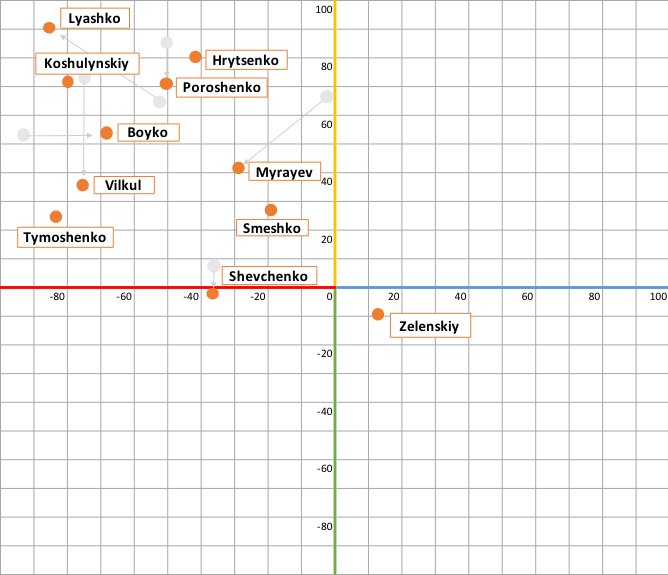
Now it is evident that although the positions seem somewhat more
dispersed, with some of the candidates even crossing the borders of the
authoritarian-left quadrant, the other three policy options (quadrants) still remain
considerably underrepresented—even alarmingly so. The only notable outlier is
Volodymyr Zelensky, but his position on the plane is based solely on his
electoral promises, due to his complete lack of political experience; thus, it cannot
be considered reliable. This prevailing trend surely signals that the most
pressing needs of the Ukrainian electorate require an authoritarian and
redistribution-oriented approach. Still, developing Ukraine as a liberal
open-market society might require consideration of other policy approaches to
solving those problems.
[i] See: Paul D’Anieri and M. E. Sharpe,“Understanding Ukrainian politics: Power, politics, and institutional design,” in Against All Odds: Aiding Political Parties in Georgia and Ukraine (2006, 82); Andrew Wilson and Artur Bilous, “Political parties in Ukraine,” Europe Asia Studies 45:4 (1993), 693–703).
[ii] See: Conover and Feldman “The origins and meaning of liberal-conservative self-identifications,” Am. J. Polit. Sci. 25 (1981), 617–45); Kerlinger, Opinion and Action in the Realm of Politics (1984); Peffley and Hurwitz, “A hierarchical model of attitude constraint,” Am. J. Polit. Sci. 29 (1985), 871–90); and Kinder, Opinion and Action in the Realm of Politics (1998).
[iii] Such as Nolan chart, Greenberg and Jonas chart, and Pournelle chart.
[iv] www.politicalcompass.org; as on the website, in this paper the adjective liberal is used synonymously to indicate the two libertarian quadrants.
[v] The polls include: Razumkov Centre, KIIS (Kyiv International Institute of Sociology), UP Foundation, and Greenberg Quinlan Rosner Research, Leading Legal Initiatives.
Research Associate, Lazarski University (Warsaw)
Denys Davydenko, Chair of the Board at the Policies Analysis and Research Coalition


